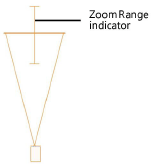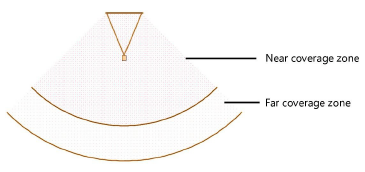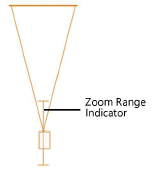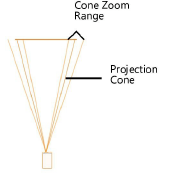 Inserting a video screen object
Inserting a video screen object
|
Tool |
Tool set |
|
Video Screen
|
Audio/Video |
Video screen objects consist of a video screen and optional front or rear projector. The video screen and projector components can be independently placed on rigging objects (see Concept: Rigging objects).
If the screen and projector are both attached to rigging objects, only the attached video screen component is affected when its rigging object moves or rotates. If only the screen component is attached to a rigging object, the entire video screen object moves or rotates with the rigging object. If only the projector component is attached to a rigging object, only the projector moves or rotates with the rigging object.
|
Mode |
Description |
|
Modes for the Symbol Insertion tool |
See The Symbol Insertion tool for parameter descriptions |
|
Preferences
|
Sets the default properties for video screen objects |
|
Place Screen
|
Places and rotates the screen and the projector at once; the projector’s location can be adjusted after placement |
|
Place Screen and Projector
|
Places and rotates the screen and projector independent of each other |
|
Screen Trim Height |
Sets the Z value of the screen at insertion |
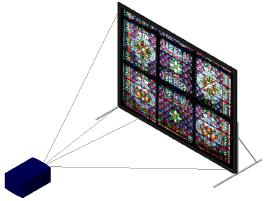
To insert a video screen:
Click the tool and the symbol insertion and alignment modes.
Click the placement mode.
Enter the Screen Trim Height value on the Tool bar.
Insert the object in the drawing.
In Place Screen mode, click to place the screen and projector, and click again to set the rotation.
In Place Screen and Projector mode, click to place the screen, click again to set the screen rotation, and click again to place the projector. This is especially useful when placing video screens on rigging objects.
The first time you use the tool in a file, a properties dialog box opens. Set the default parameters. The parameters can be edited later from the Object Info palette.
The height of the video screen and associated projector(s) depends on several factors.
The Z value determines the distance from the active layer plane to the bottom of the screen (including the border).
When the screen includes legs, the legs are drawn on the active layer plane unless a Floor Height value has been specified. The Floor Height distance shifts the floor, and therefore the legs, by that amount from the layer plane.
Projector stands are inserted relative to both the Vertical Shift and Floor Height values, allowing stands to be shifted up or down from the screen’s floor as set by the Floor Height value.
In Top/Plan view, when one of the video screen components, either the screen or the projector, is placed on a rigging object, that component assumes the height of the rigging object and associates with it. In a 3D view, the height is determined by the component's insertion point on the rigging object. The Manage Loads tool allows precise repositioning of the video screen components; see Managing loads.
Click to show/hide the parameters.Click to show/hide the parameters.
|
Parameter |
Description |
|
Screen Type |
Select the screen type: rear or front projector, or LED screen |
|
Aspect |
Select one of the standard screen aspect ratios, or choose custom screen dimensions |
|
Stock Size |
Select one of the standard screen sizes based on height x width measurements |
|
Height (image) |
Displays the height of the screen image area (without the screen border or frame) for standard screen sizes. For custom screens, enter the screen height; the screen width is automatically calculated for all custom screens (except rect. all custom dimensions). |
|
Width (image) |
Displays the width of the screen image area (without the screen border or frame) for standard screen sizes. For custom screens, enter the screen width; the screen height is automatically calculated for all custom screens (except rect. all custom dimensions). |
|
Diagonal (calc) |
Displays the calculated diagonal screen size |
|
Show Centerline |
Adds a centerline indicator in Top/Plan view |
|
Show Screen Zoom Range (Projector zoom Lens only) |
Indicates the optimal distance from the projector where the screen can be placed, given the zoom range of the lens
|
|
Diameter (image) |
For round custom screens, indicates the screen diameter |
|
Frame |
Select the type of border around the image area: No Frame, a Frame with a specified thickness, or a flat Border Only |
|
Border Width(s) Top/Bottom/Left/Right |
For Frame and Border Only types, specify the width of the frame or border for each side of the frame or border |
|
Depth |
For Frame type, indicate the thickness of the frame |
|
Edge |
For Frame type, sets the distance between the screen and the front face of the screen’s frame |
|
Tab-Tensioned Sides |
When the frame type is Border Only and the screen support is Roll-Down Case, this option is available. Select the option to specify that the side support mechanism is tab-tensioned. |
|
Tilt |
When no Screen Legs are selected, specifies the tilt of the screen in degrees. Positive values tilt the top of the screen away from the viewer, and negative values tilt it toward the viewer. |
|
Total Clearance |
Displays the total vertical clearance height required by the complete video screen object from the floor to the top of the screen, including any border, dress kit, valance, or other accessories |
|
Show Coverage Zone (2D only) |
Indicates the viewing area based on the screen size; observers within the area should be able to see the screen
|
|
Zone Reference |
Calculates the coverage zone based on screen width, height, or diagonal measurement |
|
Max Horiz. Angle/ Max Vert. Angle |
Indicates the maximum viewing angle of the screen, horizontally and vertically, relative to dead-on |
|
Viewing Height |
Enter the height of the average viewer when watching (likely, a seated height) |
|
Near Multiplier |
Specifies the multiplier of the reference dimension to determine the extent of the near coverage zone |
|
Far Multiplier |
Specifies the multiplier of the reference dimension to determine the extent of the far coverage zone |
|
Screen Support |
Select the type of screen support: None, Goalpost Legs (includes two legs, and is similar to commercial “fastfold” systems), Tripod (creates a “roll-up” type support arrangement), Sliders (generates the cable to connect the video screen to a truss object), Roll-Down Case, or Roll-Up Case |
|
Show Feet |
For Goalpost configurations, select how the feet of the frame display: Both, Front, Back, or None |
|
Depth |
For case supports, specifies the size of the case drawn at the top (roll-down case) or bottom (roll-up case) of the video screen; the case length is determined by the screen size |
|
Motor |
For case supports, adds space to the case for the motor; select whether the motor is located on the right or the left |
|
Opening |
For case supports, sets the location on the case where the screen exits the case; select Front, Center, or Back |
|
Add Dress Kit |
When Goalpost or Tripod screen legs are selected, adds a "dress kit" of draperies to conceal the projector (rear) and supports from audience view |
|
Dress Kit Color |
Select the color of the dress kit draperies |
|
Left Leg Width |
Indicates the width of the drapery on the left side of the screen |
|
Right Leg Width |
Indicates the width of the drapery on the right side of the screen |
|
Valance Height |
Sets the height of the drapery above the screen |
|
Border Overlap |
Indicates the amount of overlap of the dress kit drapery over all sides of the screen’s border |
|
Pleat Width |
Specifies the width of each pleated section of the left, right, and valance draperies |
|
Pleat Depth |
Specifies the depth of the pleats for the left, right, and valance draperies |
|
Hide Screen |
Toggles the display of the screen geometry |
|
Edit Screen Image |
Opens the Edit Screen Image dialog box; see Setting the image on the video screen |
|
Screen Image |
Displays the name of the current screen image |
|
Show Projector |
Toggles the display of the projector unit |
|
Show Projection Cone |
Toggles the display of the projection cone |
|
Projector |
Select the projector model from a library |
|
Wattage |
Enter the required wattage, for power consumption calculations and reporting |
|
Independent Aspect |
Allows an aspect ratio for the projector that is different from the screen’s aspect ratio |
|
Aspect |
Select the projector's aspect ratio |
|
L/R Shift |
Shifts the projector to the left or right relative to the screen |
|
Horiz. Offset Angle |
Displays the angle of offset from the projector to the screen, measured side to side on the horizontal plane and based on the L/R Shift value |
|
Horiz. Offset Perc. |
Displays the angle of offset from the projector to the screen as a percentage |
|
Point at Screen Center |
When the projector has been shifted to the left or right, keeps the projector pointed at the center of the screen |
|
Tilt |
Sets the tilt of the projector, in degrees, relative to the horizontal plane |
|
Place Based On |
Sets the position of the projector either based on a fixed lens size or the projection distance |
|
Proj. Distance (Straight) |
When Distance is selected for the projector placement, enter a projector distance value or click and drag the projector control point to set the distance |
|
Proj. Distance (Actual) |
Specifies the distance in 3D from the projector to the screen |
|
Lens |
Select a standard fixed or zoom lens size, or choose Custom |
|
Zoom Factor |
For zoom or custom lenses, sets the lens zoom factor |
|
Show Projector Zoom Range (Projector zoom Lens only) |
Indicates the optimal distance from the screen where the projector can be placed, given the zoom range of the lens
|
|
Show Cone Zoom Range (Projector zoom Lens only) |
Indicates the optimal screen size, given the cone zoom range of the lens
|
|
Vertical Position |
Select the projector placement mode. Screen Center: The center of the projector lens aligns with the screen center Align to Top: The top of the projector body aligns with the top of the screen border Align to Bottom: The bottom of the projector body aligns with the bottom of the screen border Stand: Places the projector on a stand selected in Stand Model Rigged: Places the projector at a height specified in Floor Height with the bottom of the projector at the Trim height Specific Shift: Shifts the projector relative to the screen center by the Vertical Shift distance, as measured from the center of the projector lens |
|
Vertical Shift |
For projectors on a stand or with a specific shift, specifies the distance between the floor (as set by the Floor Height) and the stand or projector (this allows stands or projectors to be placed on a plane shifted up or down from the screen) |
|
Stand Model |
For projectors on a stand, select the projector stand model from a library |
|
Floor Height |
For rigged projectors or projectors on a stand, indicates the distance from the active layer plane to the floor, effectively shifting the floor by the indicated height |
|
L/R Shift |
For projectors on a stand, shifts the stand to the left or right, relative to the projector |
|
F/B Shift |
For projectors on a stand, shifts the stand to the front or back, relative to the projector |
|
Trim (bottom) |
For rigged projectors, indicates the location of the bottom of the projector |
|
Vert. Offset Angle |
Displays the vertical offset angle of the projector to the screen, based on the vertical position of the projector |
|
Vert. Offset Perc. |
Displays the vertical offset angle of the projector to the screen as a percentage |
|
Multiple Projector |
When there is more than one projector, select whether they are stacked or side-by-side |
|
Horiz Space |
For side-by-side multiple projectors, sets the distance between the projectors |
|
Offset Distance |
For side-by-side multiple projectors, sets the offset distance between the screen and the second projector, relative to the first projector |
|
Note |
Adds a note, which can be placed in the drawing with the Text Options |
|
Text Options |
Opens the Text Options dialog box, to enable the display and format the text of labels |
|
Default Text Positions |
Restores text labels to their default positions |
|
Opens the Classes dialog box, to specify class naming for the various portions of the video screen. This allows portions of the video screen, projector, and other elements to be set to visible, grayed, or invisible. Use the standard class, select a class from the list of classes present in the drawing, or create a new class. Select <Video Screen Class> to place the video screen element in the same class as the video screen. Class Prefix: Specifies an optional default root class naming standard for all video screen parts; click Assign Default Classes With Prefix to begin all video screen class names with the prefix, so that they are sorted together. Assign Default Classes With Prefix: Sets the class names for all video screen elements to the standard, using the Class Prefix if there is one. Video screen elements: For each portion of the video screen, specifies the class name standard; the class names shown here are applied to the elements. |
|
|
Update |
Updates the object when changes have been made to the Object Info palette parameters |
|
Load Information |
A projector is considered a point load in Braceworks calculations, while the video screen is considered a distributed load; if the insertion point is on, or along, a rigging object, it is considered to be a load on that structure. Load information is used for Braceworks calculations and reports (Braceworks required). |
|
Include in Calculations (Braceworks required) |
Includes the projector or video screen in Braceworks calculations; deselect each one to exclude it from participating in structural calculations Only Rear Projector or Front Projector Screen Type can be included in calculations. |
|
Load Group Name |
The load category is always Video for projector and video screen objects |
|
Load ID |
Enter a unique ID for the load for informational use in reports |
|
Load Name |
Identifies the object in load calculations |
|
Total Weight (projector) |
Enter the total weight of the object |
|
Distributed Weight (video screen) |
Enter the distributed weight of the video screen object; changes here also affect the Total Weight value |
|
Total Weight (video screen) |
Enter the total weight of the object |
|
Position |
Displays the name of the associated rigging object, if the video screen or projector is attached. Optionally, attach this object to a rigging object, or change the rigging object association, by entering the Position Name of the rigging object. Delete the name to break the association. For other methods to attach loads, see Making the attachment. |
|
Equipment Subparts |
Lists the subparts that make up the object. These subparts are counted and reported separately in equipment and inventory lists. The parameters must be selected for display for this type of object in Spotlight preferences: Inventory pane. |
|
Equipment Virtual Parts |
Virtual parts are associated with an object and are reported in equipment and inventory lists, but do not display in the drawing. After adding virtual parts, they are listed in the Object Info palette. |
|
Edit Virtual Parts |
Opens the Virtual Parts dialog box to add virtual parts to the object; see Managing virtual parts and independent virtual parts |
|
Assign Sources |
Opens the Assign Sources dialog box to assign the object and its subparts and virtual parts to an inventory source; see Assigning equipment to an inventory |





